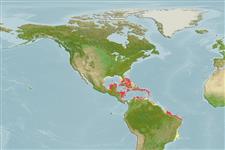>
Gobiiformes (Gobies) >
Gobiidae (Gobies) > Gobiinae
Etymology: Coryphopterus: Greek, koryphe = summit + Greek, pteron = fin, wing (Ref. 45335).
More on authors: Böhlke & Robins.
Environment: milieu / climate zone / depth range / distribution range
Écologie
marin récifal; profondeur 6 - 30 m (Ref. 9710). Tropical
Western Atlantic: southern Florida, USA and Bahamas to the Lesser Antilles (Ref. 7251). Has occasionally been recorded in northeastern Brazil (Ref. 84211).
Taille / Poids / Âge
Maturity: Lm ? range ? - ? cm
Max length : 6.0 cm TL mâle / non sexé; (Ref. 7251)
Épines dorsales (Total) : 6 - 7; Rayons mous dorsaux (Total) : 9 - 11; Épines anales: 1; Rayons mous anaux: 8 - 9. Translucent gray with a narrow yellow stripe, faintly edged with dusky pigment, extending posteriorly from eye, and small yellow or dusky yellow spots or short bands on snout, cheek and anteriorly on body; a row of small faint yellow spots dorsally on body (Ref. 13442).
Inhabits reef areas deeper than 6 m.
Life cycle and mating behavior
Maturities | Reproduction | Spawnings | Egg(s) | Fecundities | Larves
Benthic spawner.
Robins, C.R. and G.C. Ray, 1986. A field guide to Atlantic coast fishes of North America. Houghton Mifflin Company, Boston, U.S.A. 354 p. (Ref. 7251)
Statut dans la liste rouge de l'IUCN (Ref. 130435)
Menace pour l'homme
Harmless
Utilisations par l'homme
Pêcheries: commercial; Aquarium: Commercial
Outils
Articles particuliers
Télécharger en XML
Sources Internet
Estimates based on models
Preferred temperature (Ref.
123201): 26.4 - 28.2, mean 27.5 °C (based on 597 cells).
Phylogenetic diversity index (Ref.
82804): PD
50 = 0.5001 [Uniqueness, from 0.5 = low to 2.0 = high].
Bayesian length-weight: a=0.01023 (0.00477 - 0.02194), b=3.02 (2.84 - 3.20), in cm total length, based on LWR estimates for this (Sub)family-body shape (Ref.
93245).
Niveau trophique (Ref.
69278): 2.0 ±0.00 se; based on food items.
Résilience (Ref.
120179): Haut, temps minimum de doublement de population inférieur à 15 mois (Preliminary K or Fecundity.).
Fishing Vulnerability (Ref.
59153): Low vulnerability (10 of 100).
Nutrients (Ref.
124155): Calcium = 194 [98, 437] mg/100g; Iron = 1.15 [0.55, 2.23] mg/100g; Protein = 17.9 [15.8, 19.6] %; Omega3 = 0.137 [0.061, 0.273] g/100g; Selenium = 25.8 [12.5, 56.7] μg/100g; VitaminA = 107 [24, 421] μg/100g; Zinc = 3.16 [2.00, 4.85] mg/100g (wet weight);
